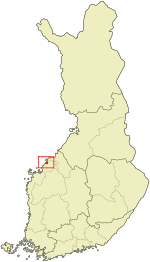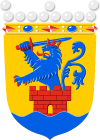Jakobstad
|
Jakobstad Jakobstad – Pietarsaari |
||
|---|---|---|
| Town | ||
|
Staden Jakobstad Pietarsaaren kaupunki |
||

The old Town Hall
|
||
|
||
 Location of Jakobstad in Finland |
||
| Coordinates: 63°40′N 022°42′E / 63.667°N 22.700°ECoordinates: 63°40′N 022°42′E / 63.667°N 22.700°E | ||
| Country |
|
|
| Region | Ostrobothnia | |
| Sub-region | Jakobstad sub-region | |
| Charter | 1652 | |
| Government | ||
| • City manager | Kristina Stenman | |
| Area (2016-01-01) | ||
| • Total | 88.45 km2 (34.15 sq mi) | |
| • Land | 88.31 km2 (34.10 sq mi) | |
| • Water | 307.94 km2 (118.90 sq mi) | |
| Area rank | 302nd largest in Finland | |
| Population (2016-03-31) | ||
| • Total | 19,464 | |
| • Rank | 58th largest in Finland | |
| • Density | 220.41/km2 (570.9/sq mi) | |
| Population by native language | ||
| • Swedish | 56.4% (official) | |
| • Finnish | 40.2% (official) | |
| • Others | 3.4% | |
| Population by age | ||
| • 0 to 14 | 17.4% | |
| • 15 to 64 | 62.7% | |
| • 65 or older | 19.9% | |
| Time zone | EET (UTC+2) | |
| • Summer (DST) | EEST (UTC+3) | |
| Municipal tax rate | 20.25% | |
| Website | www.jakobstad.fi | |
Jakobstad (Finnish: Pietarsaari) is a town and municipality in Ostrobothnia, Finland. The town has a population of 19,464 (31 March 2016) and covers a land area of 88.31 square kilometres (34.10 sq mi). The population density is 220.41 inhabitants per square kilometre (570.9/sq mi). Neighbour municipalities are Larsmo, Pedersöre, and Nykarleby.
The Swedish name literally means Jacob's City or Jacob's Town, in reference to Jacob De la Gardie. The town was founded at the old harbour of the parish Pedersöre and this name lives on in the Finnish name of the municipality, Pietarsaari, literally Peter's Island.
The town was founded in 1652 by Ebba Brahe, the widow of the military commander Jacob De la Gardie, and was granted city privileges by Queen Christina of Sweden. The town was founded at the old harbour of the parish Pedersöre. Pedersöre remains an independent municipality neighbouring Jakobstad.
The city grew slowly at first, with the authorities scarcely promoting any growth. In 1680 the inhabitants were ordered to relocate to the cities of Karleby (Kokkola), Uleåborg (Oulu) and Nykarleby, but the order was rescinded. Wars also contributed to the slow growth, and the city was invaded by Russian troops twice during the Greater Wrath, and large parts of the town were burnt to the ground. A majority of the inhabitants fled the city. While those with means moved across the sea to the Swedish side, others took shelter in the forest or in the archipelago. Many were captured or killed. During the 1720s, some of the previous inhabitants returned, while newcomers also added to the population. The subsequent decades were finally marked by a period of growth, and the current church was built in 1731.
...
Wikipedia

